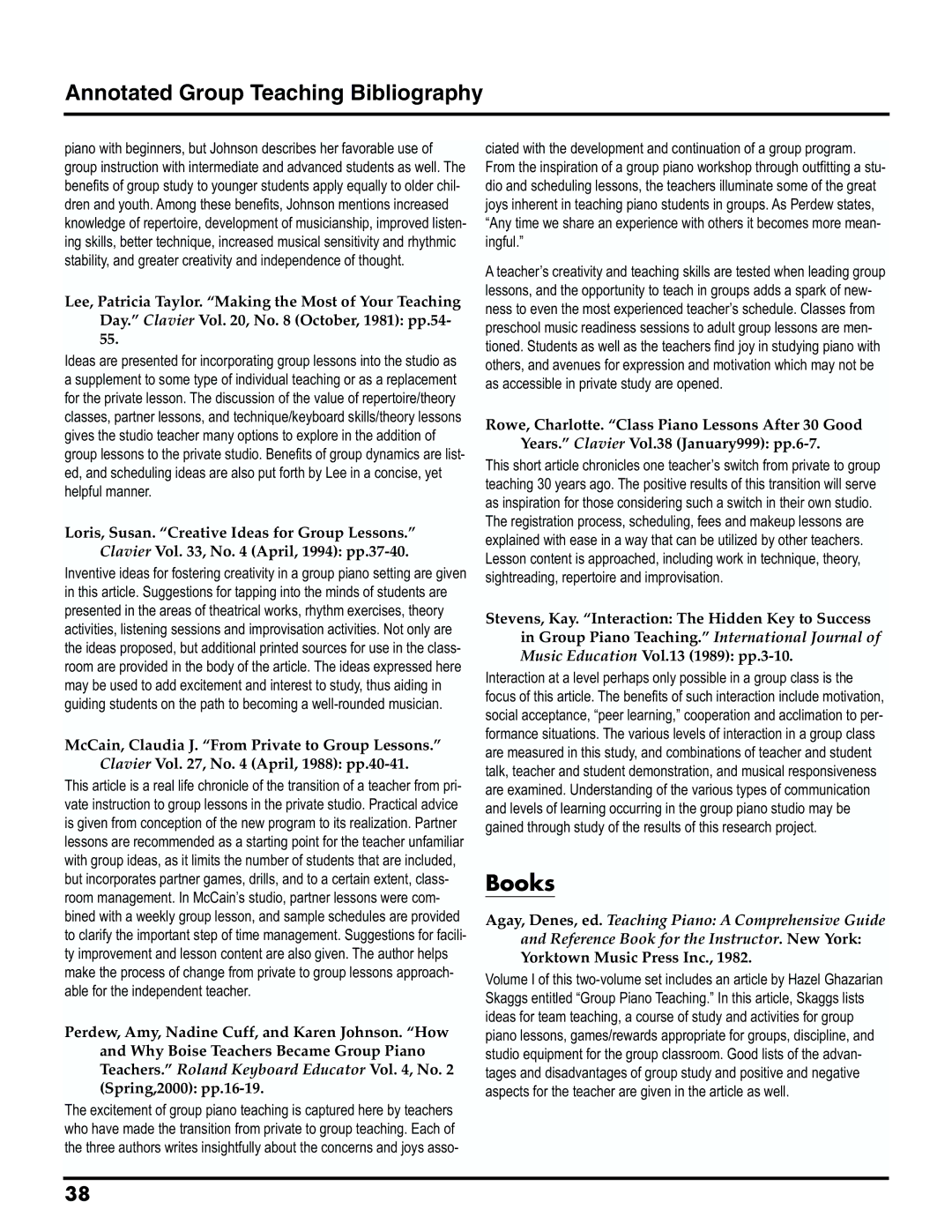
Annotated Group Teaching Bibliography
piano with beginners, but Johnson describes her favorable use of group instruction with intermediate and advanced students as well. The benefits of group study to younger students apply equally to older chil- dren and youth. Among these benefits, Johnson mentions increased knowledge of repertoire, development of musicianship, improved listen- ing skills, better technique, increased musical sensitivity and rhythmic stability, and greater creativity and independence of thought.
Lee, Patricia Taylor. “Making the Most of Your Teaching Day.” Clavier Vol. 20, No. 8 (October, 1981): pp.54- 55.
Ideas are presented for incorporating group lessons into the studio as a supplement to some type of individual teaching or as a replacement for the private lesson. The discussion of the value of repertoire/theory classes, partner lessons, and technique/keyboard skills/theory lessons gives the studio teacher many options to explore in the addition of group lessons to the private studio. Benefits of group dynamics are list- ed, and scheduling ideas are also put forth by Lee in a concise, yet helpful manner.
Loris, Susan. “Creative Ideas for Group Lessons.” Clavier Vol. 33, No. 4 (April, 1994):
Inventive ideas for fostering creativity in a group piano setting are given in this article. Suggestions for tapping into the minds of students are presented in the areas of theatrical works, rhythm exercises, theory activities, listening sessions and improvisation activities. Not only are the ideas proposed, but additional printed sources for use in the class- room are provided in the body of the article. The ideas expressed here may be used to add excitement and interest to study, thus aiding in guiding students on the path to becoming a
McCain, Claudia J. “From Private to Group Lessons.” Clavier Vol. 27, No. 4 (April, 1988):
This article is a real life chronicle of the transition of a teacher from pri- vate instruction to group lessons in the private studio. Practical advice is given from conception of the new program to its realization. Partner lessons are recommended as a starting point for the teacher unfamiliar with group ideas, as it limits the number of students that are included, but incorporates partner games, drills, and to a certain extent, class- room management. In McCain’s studio, partner lessons were com- bined with a weekly group lesson, and sample schedules are provided to clarify the important step of time management. Suggestions for facili- ty improvement and lesson content are also given. The author helps make the process of change from private to group lessons approach- able for the independent teacher.
Perdew, Amy, Nadine Cuff, and Karen Johnson. “How and Why Boise Teachers Became Group Piano Teachers.” Roland Keyboard Educator Vol. 4, No. 2 (Spring,2000):
The excitement of group piano teaching is captured here by teachers who have made the transition from private to group teaching. Each of the three authors writes insightfully about the concerns and joys asso-
ciated with the development and continuation of a group program. From the inspiration of a group piano workshop through outfitting a stu- dio and scheduling lessons, the teachers illuminate some of the great joys inherent in teaching piano students in groups. As Perdew states, “Any time we share an experience with others it becomes more mean- ingful.”
A teacher’s creativity and teaching skills are tested when leading group lessons, and the opportunity to teach in groups adds a spark of new- ness to even the most experienced teacher’s schedule. Classes from preschool music readiness sessions to adult group lessons are men- tioned. Students as well as the teachers find joy in studying piano with others, and avenues for expression and motivation which may not be as accessible in private study are opened.
Rowe, Charlotte. “Class Piano Lessons After 30 Good Years.” Clavier Vol.38 (January999):
This short article chronicles one teacher’s switch from private to group teaching 30 years ago. The positive results of this transition will serve as inspiration for those considering such a switch in their own studio.
The registration process, scheduling, fees and makeup lessons are explained with ease in a way that can be utilized by other teachers. Lesson content is approached, including work in technique, theory, sightreading, repertoire and improvisation.
Stevens, Kay. “Interaction: The Hidden Key to Success in Group Piano Teaching.” International Journal of Music Education Vol.13 (1989):
Interaction at a level perhaps only possible in a group class is the focus of this article. The benefits of such interaction include motivation, social acceptance, “peer learning,” cooperation and acclimation to per- formance situations. The various levels of interaction in a group class are measured in this study, and combinations of teacher and student talk, teacher and student demonstration, and musical responsiveness are examined. Understanding of the various types of communication and levels of learning occurring in the group piano studio may be gained through study of the results of this research project.
Books
Agay, Denes, ed. Teaching Piano: A Comprehensive Guide and Reference Book for the Instructor. New York: Yorktown Music Press Inc., 1982.
Volume I of this
38
